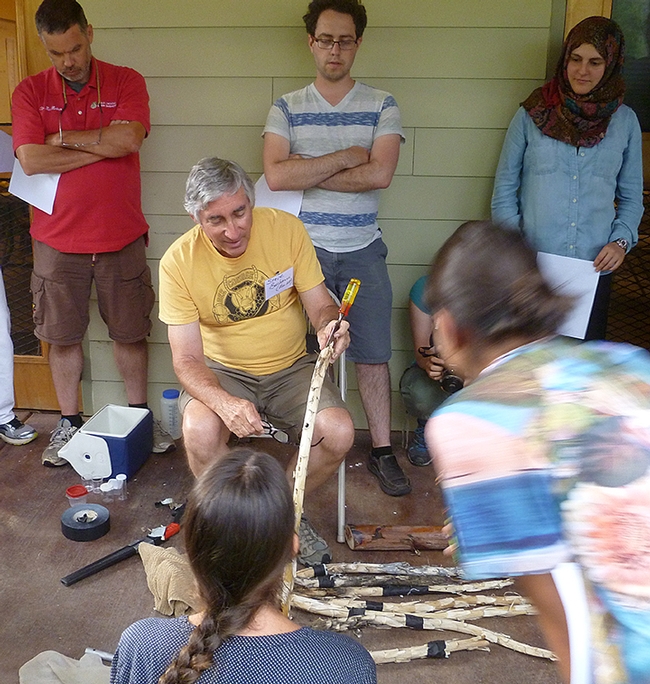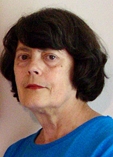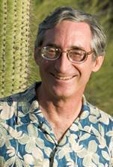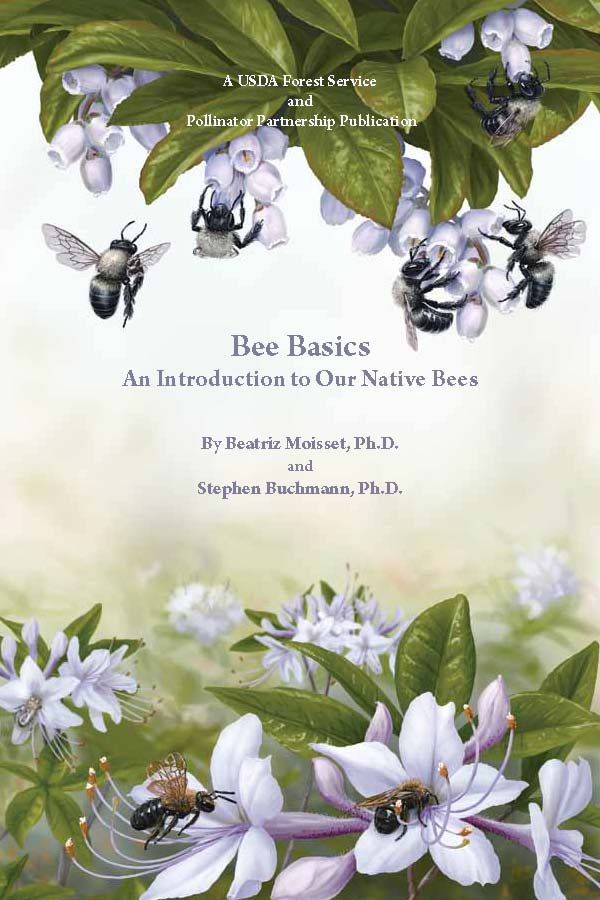- Author: Kathy Keatley Garvey

The UC Davis-trained entomologist, author of the newly published paperback book, The Reason for Flowers: Their History, Culture, Biology, and How They Change Our Lives, "has been on the cutting edge of many areas of pollination biology," said Robbin Thorp, distinguished emeritus professor of entomology at UC Davis who served as his major professor. Buchmann, who received his doctorate in entomology from UC Davis in 1978, is a researcher and adjunct professor in the departments of entomology and ecology and evolutionary biology at the University of Arizona, Tucson.
"Steve jumps onto new ideas with great enthusiasm and explores them in depth," Thorp said. "He has been a leader in areas like buzz pollination, the contribution of electrostatics in pollen harvesting by bees, and adaptations in bees that collect oils from specialized flowers. He raised important issues about the conservation of bees in co-authoring the benchmark book, The Forgotten Pollinators, a decade before colony collapse disorder (CCD) in honey bees captured the attention of the media and general public."

Thorp and Buchmann are among the instructors at The Bee Course, which attracts conservation biologists, pollination ecologists and other attendees from all over the world. It's affiliated with the American Museum of Natural History.
So last year when Simon & Schuster published Buchmann's latest book, Reason for Flowers, it drew quite a splash. Bee scientists and bee enthusiasts, teachers and students, and lovers of flowers and just plain lovers, grabbed copies of the book, which, as of Feb. 9, is now in paperback. National Public Radio (NPR) interviewed him.
One word immediately grabbed everyone's attention: "sex."
"The reason for flowers is actually one word: sex," Buchmann told NPR's Arun Rath. "So, flowers are literally living scented billboards that are advertising for sexual favors, whether those are from bees, flies, beetles, butterflies or us, because quite frankly most of the flowers in the world have gotten us to do their bidding. But that's only the first stage because flowers, if they're lucky, turn into fruits, and those fruits and seeds feed the world."
A scientist who seemingly never sleeps, Buchmann has published more than 150 scientific articles and 11 popular nonfiction books, including The Forgotten Pollinators (a Los Angeles Times Book Prize finalist) with Gary Nabhan. His book, Honey Bees: Letters from the Hive, is a National Science Teachers' Association Outstanding Science Trade Book. He's also written a children's book The Bee Tree (with Diana Cohn), described as the true story of a family of honey hunters in peninsular Malaysia.
So, we asked Buchmann to provide "10 reasons for flowers." He provides greater detail in his book, but here are 10 reasons:
- Flowers Feed The World. Because pollinated and fertilized blossoms turn into nutritious fruits and seeds, these invaluable foodstuffs keep the world's 7.2 billion people from starvation. These resulting fruits also feed birds, bears and other wildlife.
- Tasty and Nutritious. Although the calories from starchy cereals and grain crops feed the world, we enjoy and need the “nutraceuticals” and antioxidants inside colorful cranberries, blueberries, oranges and apples. They keep us healthy and happy.
- Edible flowers. Some flowers (e.g. roses, some marigolds) are great as edible garnish and foods. Find out which ones can be eaten and what they taste like.
- Humans might never have evolved, or survived. Early hominids certainly recognized that flowers were the harbingers of tasty fruits. Without flowers, perhaps no people today.
- Flowers make us smile. Give someone a flower(s) and they flash a genuine Duchenne smile. Rutgers psychologist Dr. Jeanette Haviland-Jones has infused subliminal amounts of rose and gardenia vs. manmade scents into room air. Subjects use more enjoyment words and were more likely to approach or touch a stranger when the floral scents were present. Flowers may counteract the semiochemicals for fear, anger and anxiety that humans seem to constantly be emitting.
- 200 million red roses! Americans buy about 10 million cut blooms every day. On Valentine's Day that can jump to 200 million cut flowers, especially red roses. Most of these flowers are grown in Columbia and Ecuador then arrive in the bellies of jumbo jets arriving at the Miami airport.
- As costly as gold. Saffron is the world's costliest spice and the subject of countless fake imitations. The spice is the dried styles from crocus blooms. Hand-picking and the fact that this represents such a tiny fraction of the entire plant, make it so costly and precious.
- For inspiration and romance. Flowers have inspired generations of poets, writers and artists. Their myriad shapes, colors and scents enrich our lives with beauty. Their sexuality and alluring scents bring romance into our lives.
- Most ancient. The world's earliest known flower is the 8-inch tall fossil Achaefructus that grew in China 130-160 million years ago. Turns out that these and other early blooms were puny runts. They wouldn't win best of show ribbons in any flower show.
- Flowers in the service of science. Without Gregor Mendel's crossing experiments with the humble garden pea, we wouldn't have learned about the laws of inheritance when we did.
So, flowers feed the world, keep us healthy and make us smile. What could be better than that?

- Author: Kathy Keatley Garvey

Billed as "the first comprehensive guide to North American bumble bees to be published in more than a century," it allows readers, both amateurs and professionals, to identify all 46 bumble bee species found in North America and learn about their ecology, changing geographic distributions, and the endangered and threatened species.
Bumble bees, you know, are among the most recognizable of the world's 20,000 species of bees. The genus, Bombus, has only 250 species. A small number, indeed.



- Author: Kathy Keatley Garvey

It's an annual workshop held at the Southwestern Research Station (SWRS) in Portal, Ariz. for conservation biologists, pollination ecologists, and other biologists "who want to gain greater knowledge of the systematics and biology of bees," according to organizer Jerome Rozen Jr. of the American Museum of Natural History (AMNH), New York.
AMNH launched the course at SWRS in 1999. This year's nine-day workshop will take place Aug. 25-Sept. 4.
Native pollinator specialist Robbin Thorp, emeritus professor of entomology at the University of California, Davis, has been teaching at the workshop since 2002. Thorp, who received his doctorate in entomology from UC Berkeley, served on the UC Davis faculty from 1964 to 1994, but although he officially "retired" in 1994, he never really did. He continues his research, writings and bee identification at his office in the Harry H. Laidlaw Jr. Honey Bee Research Facility at UC Davis.
Frankly, we at UC Davis don't know what we'd do without him. Thorp maintains a massive educational, research and public service work that brings national and worldwide pride and distinction to UC Davis. No one can say “pollinators” without thinking of Thorp. For example, MacArthur Foundation Fellow Claire Kremen, a conservation biologist with the UC Berkeley Department of Environmental Science, Policy and Management, said she would never have attempted her much-cited Yolo County pollinator project without his expertise. He not only helped develop the protocol, but he identifies all the species—about 60,000 of them since 1999.

Robbin Thorp will turn 80 years young during The Bee Course. Shhh--don't tell anyone. (P.S., he says it's okay to "tell.")
Thorp and his colleague John Ascher, an assistant professor at the National University of Singapore and research associate at the American of Natural History, New York, and a key scientist at BugGuide.Net, were working today at the Bohart Museum of Entomology at UC Davis. We captured a quick image of them (below).
Ascher, who received his doctorate in entomology from Cornell University, has taught at The Bee Course since 2004.
The Bee Course textbook is The Bee Genera of North and Central America, Michener, C.D., R.J. McGinley and B.N. Danforth, 1994, Smithsonian Press.
Why in Portal, Ariz.? It's one of the richest bee faunas in North America.
All the instructors are volunteers. In addition to Rozen, Thorp and Ascher, the 2013 team includes Stephen Buchmann of Tucson, who received his doctorate in entomology from UC Davis; James H. Cane and Terry Griswold of the USDA-ARS Bee Biology and Systematics Lab at Utah State University, Logan; Lawrence Packer of York University, Toronto, Canada; and UC Davis alumnus Ronald McGinley of Dewey, Ill. (he obtained his doctorate in entomology from UC Berkeley and then worked at Harvard University and the Smithsonian before joining the Illinois Natural History Survey).
The participants, usually around 22, come from all over the world. They will return home with a collection of properly labeled bee specimens--and a comprehensive knowledge about bees.
From the website: The course "emphasizes the classification and identification of more than sixty bee genera of North and Central America (both temperate and tropical), and the general information provided is applicable to the global bee fauna. Lectures include background information on the biologies of bees, their floral relationships, their importance in maintaining and/or improving floral diversity, inventory strategies, and the significance of oligolecty (i.e., taxonomic floral specialization). Field trips acquaint participants with collecting and sampling techniques; associated lab work provides instruction on specimen identification, preparation and labeling."
And the course significance: "The field of pollination ecology explores the reproductive biology of plants in general, including the biotic and abiotic agents associated with pollination and seed-set. This is of interest for basic research and understanding of world communities and also has significant practical impact as it relates to pollination of economically important crop plants, to survival of endangered plants, and to plant reproduction in threatened habitats. Pollen is moved between receptive flowers by wind, water, birds, bats, beetles, flies, etc., but the 20,000 species of bees worldwide play a dominant role in the sexual reproduction of most plant communities. This course will empower students with 1) the confident use of The Bee Genera of North and Central America, 2) an appreciation for the biological diversity of bees, and 3) sufficient background to learn more about bees and investigate pollination and conservation problems with greater insight."
Said Thorp: "It is a great experience for students to interact with instructors and especially with their peers from around the world. Instructors all donate their time to teach in the course, but benefit from the chance to get together with colleagues and a new cohort of interesting students each year. Every class is different. that is, it takes on its own personality, and each student brings something new and different to the mix."


- Author: Kathy Keatley Garvey

On every field trip, we see something new and different, such as the male long-horned bee, Melissodes communis (below) on salvia and the female sunflower bee, Svastra obliqua expurgata, on a Mexican hat flower.
With so much interest in pollinators, it's good to see that biologist Beatriz Moisset has written a downloadable book, "A Beginners Guide to Pollinators and other Flower Visitors." It's meant for young adults and beginners.
Moisset, a resident of Willow Grove, Penn., received her doctorate in biology from the University of Cordoba, Argentina. She completed her postdoctoral work at the Jackson Laboratories, Bar Harbor, Maine, studying neurochemistry and behavior.
She's "retired," but like so many dedicated biologists, she's not. She's a talented artist, photographer, author and public speaker.
Moisset's book, available for a nominal price, covers the most common flower visitors, including pollinators. It includes brief descriptions, illustrations, geographic distribution, habitat and season.
You'll find her insect photography and text on BugGuide.Net and on her pollinator blog, http://pollinators.blogspot.com/. Check out her amazing photos!
And her book? It's available through Barnes and Noble, Lulu.com, and ITunes.
We remember that back in 2011, she teamed with entomologist Stephen Buchmann, who received his doctorate in entomology in 1978 from UC Davis (his major professor was Robbin Thorp), to publish the USDA Forest Service/Pollinator Partnership publication, "Bee Basics: An Introduction to Our Native Bees" with illustrator Steve Buchanan. (Just click on the link to download.)
The more we know about our native bees and the flowers they pollinate, the more we can protect them.
"We are all part of the web of life," Moisset writes on her blog. "Animals need plants and plants need animals and ultimately we all need each other in a very intricate and complex web of interactions."
So true.


- Author: Kathy Keatley Garvey

Not all floral visitors are bees.
That's why we're glad to see the publication of Bee Basics: An Introduction to Our Native Bees.
It will introduce folks to such native bees as leafcutter bees, sweat bees and bumble bees.
It's co-authored by retired biologist Beatriz Moisset of Willow Grove, Pa., and entomologist Stephen Buchmann, international coordinator of the Pollinator Partnership, based in San Francisco. The illustrations, based on Buchmann's photos, are by Steve Buchanan of Wingsted, Conn., known for creating the U.S. Postal Service’s pollinator stamps that were issued June 29, 2007.

“From forests to farms, from cities to wildlands, there are 4000 native bee species in the United States, from the tiny Perdita minima to large carpenter bees,” they wrote.
“The honey bee, remarkable as it is, does not know how to pollinate tomato or eggplant flowers. It does very poorly compared to native bees when pollinating many native plants, such as pumpkins, cherries, blueberries, and cranberries.”
The book includes descriptions and illustrations of bees from such families as Apidae, Andrenidae, Halictidae, Megachilidae and Colletidae.
They wrote: “The members of the five most common families, Apidae, Halictidae, Andrenidae, Megachilidae and Colletidae, can be found throughout the North American continent from Canada and Alaska to warm and sunny Florida and Mexico; from forests to deserts; from remote wildernesses to gardens and backyards; even the National Mall in the heart of our nation’s capital sports a native bee fauna. Perhaps the only places where bees are absent are the high mountains.”
“There is even a hardy little bee, the arctic bumble bee, which lives within the Arctic Circle.”
The booklet also offers tips on how to attract pollinators. A great resource!
Steve Buchmann, of Tucson, Ariz., received his doctorate in entomology from the University of California, Davis with major professor Robbin Thorp. Now an adjunct faculty member in the entomology and EEB (Ecology and Evolutionary Biology) departments at the University of Arizona, Buchmann is the author of 150 scientific publications and 12 bbooks, including The Forgotten Pollinators.
Beatriz Moisset, born in Argentina and a resident of the United States for more than 40 years, obtained her doctorate in biology from the University of Cordoba, Argentina. She completed her postdoctoral work at the Jackson Laboratories, Bar Harbor, Maine studying neurochemistry and behavior. A multitalented person (she's an artist, photographer, author and public speaker), she has displayed her pastels and oil paintings at many art shows and contributes her insect photography to the online resource BugGuide.Net.
“I became interested in pollinators after my retirement, combining photography and painting with field observations,” Moisset said.
The book, a USDA Forest Service and Pollinator Partnership Publication, can be ordered from the Pollinator Partnership website for a small donation.



